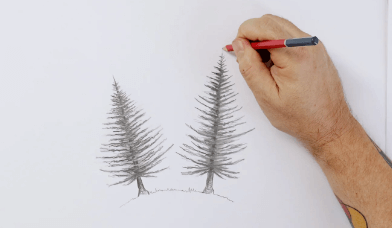Drawing:9sn1eqhlw6e= Pine Tree

The art of drawing a pine tree encompasses an intricate balance of technique and observation, requiring a deep understanding of its unique anatomical features. From the foundational outline to the application of shading techniques, each step contributes to a more nuanced representation of this iconic tree. As one navigates through the essentials of materials and methods, the challenge lies not only in capturing its form but also in conveying the essence of its resilience and beauty. What specific techniques can elevate a simple sketch into a compelling visual narrative?
Understanding Pine Tree Anatomy
While many may recognize pine trees for their distinctive conical shape and needle-like leaves, a deeper understanding of their anatomy reveals a complex structure that supports their growth and ecological function.
The pine tree structure includes a robust trunk, extensive root system, and various leaf types, predominantly needle-like foliage, which enhances photosynthesis while minimizing water loss, crucial for survival in diverse environments.
See also: Drawing:9gyzs4ejuzg= Pose
Essential Drawing Materials
To effectively capture the intricate details and unique characteristics of a pine tree, selecting the appropriate drawing materials is essential.
High-quality sketching tools, such as graphite pencils and charcoal, offer versatility for varying line weights.
Additionally, employing refined shading techniques, like cross-hatching or blending, enhances depth and texture, allowing artists to render the pine tree’s form with precision and artistic freedom.
Step-by-Step Drawing Techniques
Capturing the essence of a pine tree through drawing requires a systematic approach that emphasizes observation and technique.
Begin with foundational sketching techniques, mapping the tree’s structure and proportions. Utilize shading methods to convey depth, focusing on light direction and texture.
Apply varied pressure on your pencil for dynamic shading, enhancing the three-dimensional quality of the tree while maintaining a natural appearance.
Adding Details and Color
Enhancing the drawing of a pine tree with intricate details and color is essential for achieving realism and vibrancy.
Employing effective shading techniques creates depth, while color blending harmonizes the hues, elevating the visual appeal.
Focus on capturing the texture of the bark and the lushness of the needles to convey authenticity.
These elements collectively transform a basic sketch into a captivating representation of nature.
Conclusion
The pine tree stands as a symbol of resilience and endurance, embodying the ability to thrive in adverse conditions. Through meticulous observation and technique, the art of drawing this tree not only captures its physical attributes but also reflects the deeper connection between nature and artistic expression. The interplay of light and shadow serves to highlight the intricate beauty of the pine, inviting viewers to appreciate the subtleties of life and the enduring strength found within nature’s forms.




